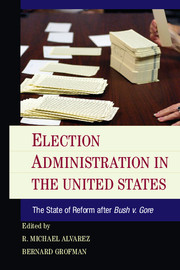Book contents
- Frontmatter
- Contents
- List of Contributors
- Foreword
- Acknowledgments
- Editors’ Introduction
- Part I Bush v. Gore in Perspective
- Part II What Has Changed since Bush v. Gore?
- Part III Remaining Challenges
- 8 The Evolution (or Not) of Ballot Design Ten Years after Bush v. Gore
- 9 Poll Workers and Polling Places
- 10 Resolving Voter Registration Problems
- 11 Felon Disenfranchisement after Bush v. Gore
- Epilogue
- References
- Index
8 - The Evolution (or Not) of Ballot Design Ten Years after Bush v. Gore
Published online by Cambridge University Press: 05 October 2014
- Frontmatter
- Contents
- List of Contributors
- Foreword
- Acknowledgments
- Editors’ Introduction
- Part I Bush v. Gore in Perspective
- Part II What Has Changed since Bush v. Gore?
- Part III Remaining Challenges
- 8 The Evolution (or Not) of Ballot Design Ten Years after Bush v. Gore
- 9 Poll Workers and Polling Places
- 10 Resolving Voter Registration Problems
- 11 Felon Disenfranchisement after Bush v. Gore
- Epilogue
- References
- Index
Summary
Introduction
Few stories in the election world are as unfortunate as that of Theresa LePore, the former supervisor of elections for Palm Beach County, Florida and designer of the now infamous butterfly ballot with the multiple-column presidential contest that confused so many voters during the 2000 election. In defending the butterfly ballot, LePore noted, “Palm Beach County has a lot of elderly voters. I was trying to make the ballot so that it would be easier for the voters to read, which is why we went to the two-page, now known as the butterfly ballot.”
Yet, four years after that fateful decision, on August 24, 2004, National Public Radio’s Melissa Block noted that Palm Beach had a new balloting system for absentee ballots: connect-the-arrow optical scan ballots. Block interviewed LePore, who noted that the arrow design had been around the United States for almost twenty years and was used in thirty-three states and DC. The interview continued with LePore saying that the connect-the-arrow ballot is easy to vote.
LePore: “[W]e decided to use the arrow because it was easier for voters to draw a line than to fill in the bubble as per a lot of studies that are out there.”
Block: “Easier to draw because you basically take one end of the arrow, there’s a gap in the middle and you connect it to the opposite end.”
LePore: “Correct, it’s basically connecting the head and tail of the arrow by just drawing a line – a simple straight line.”
Block: “And the arrow is pointing to the candidate of your choice?”
LePore: “Correct.”
- Type
- Chapter
- Information
- Election Administration in the United StatesThe State of Reform after Bush v. Gore, pp. 157 - 174Publisher: Cambridge University PressPrint publication year: 2014
- 1
- Cited by



